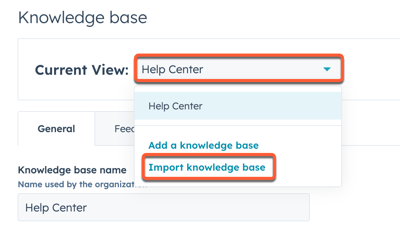- Knowledge Base
- Service
- Knowledge Base
- Import knowledge base articles
Import knowledge base articles
Last updated: August 15, 2025
Available with any of the following subscriptions, except where noted:
-
Service Hub Professional, Enterprise
You can import articles from an external knowledge base hosted on Freshdesk, Help Scout, Zendesk, or Intercom into HubSpot. You can also import your knowledge base from a CSV file.
Understand limitations & considerations
-
You can not import tables into a knowledge base.
-
Only 400 articles can be included in a single import.
- Importing a knowledge base from a homepage URL using Smart copy is only available for newly created and migrated knowledge bases.
- Importing a knowledge base from a CSV file requires the following fields:
- URL
- Title
- Category
- Article Body
Import your knowledge base from homepage URL
- In your HubSpot account, click the settings settings icon in the top navigation bar.
- In the left sidebar menu, navigate to Content > Knowledge Base.
- In the Current view section, click the first dropdown menu and select Import knowledge base. In accounts with the Brands add-on, this will be the second dropdown menu.

- On the Import your knowledge base page, click Previous on the bottom left.
- Select the Smart copy option, then click Next.
- Select an option for importing your articles:
- Import and publish: the imported articles will immediately be published live for visitors to see.
- Import as a draft: the imported articles will be imported as drafts in your knowledge base and can only be seen by visitors once they are manually published.
- Click Import to start the import process.

- In your HubSpot account, navigate to Service > Knowledge Base.
- Click the Articles tab.
- At the top of the page, view the import progress.

Import your knowledge base from a CSV file
You can import your knowledge base from a CSV file. Review a sample CSV file to format your knowledge base content for your import.
Import your knowledge base
- In your HubSpot account, click the settings settings icon in the top navigation bar.
- In the left sidebar menu, navigate to Content > Knowledge Base.
- In the Current view section, click the first dropdown menu and select Import knowledge base. In accounts with the Brands add-on, this will be the second dropdown menu.

- Select the CSV file upload option, then click Next.
- Click the Which knowledge base platform are you currently using dropdown menu and select the platform where you are currently hosting your knowledge base.
- Click the HubSpot knowledge base dropdown menu and select a knowledge base.
- In the CSV file upload section, click Select a file, then upload your CSV file.
- In the bottom right, click Copy articles.
Map the columns from your import file
Next, you'll map the columns of your CSV file to the corresponding properties in your new HubSpot knowledge base.
Learn more about HubSpot article properties below. To see an example of how to format your CSV file and the article content you're importing, review the sample CSV import file.
- URL (required): enter the URL of each article in this column.
- Title (required): enter the title for each article in this column
- Category (required): enter the category for each article in this column. To set the value in HubSpot to Uncategorized, you can leave this field blank in your file.
- Subcategory: enter the subcategory for each article in this column.
- Article Body (required): enter the source code of the article content, including image URLs, in this column. For an example of how to format the article body, see the sample CSV import file.
- Keywords: enter the search keywords for each article, separated by commas, in this column.
Please note: if any keywords have a space after the comma separating them from the next keyword, you will receive an error that those tags couldn't be imported.
- Subtitle: enter the subtitle for each article in this column.
To map the article content from your CSV files into your new knowledge base in HubSpot:
- Click the dropdown menu to edit the HubSpot knowledge base property that a column should map to.
- Once you're done, click Next in the lower right. The import process may take a few minutes to complete.
- Click return to the dashboard to see the status of your import.
Finish the import
Once your CSV data has been imported, you can finish importing your knowledge base.
- On the dashboard, click Review results to review the data from your CSV file. Click Delete to delete the import.
- On the results page, view articles that are ready to import. You can also click the Errors tab to view any errors from your import file.
- Select the checkboxes next to the articles you'd like to import, then click Import in the bottom right.
- In the pop-up box, select an option for how your articles are published:
- Import all contents as "Draft": the imported articles will be imported as drafts in your knowledge base and can only be seen by visitors once they are manually published.
- Import all contents as "Published": the imported articles will immediately be published live for visitors to see.
- To replace existing content that has the same URL as an imported article, select the checkbox to Overwrite any existing content with imported content. If you replace existing content by selecting the checkbox, this will reset article analytics.
- Click Save to finalize the import.
- On the import dashboard, view the progress of the import. Once completed, click View articles to view the imported articles.